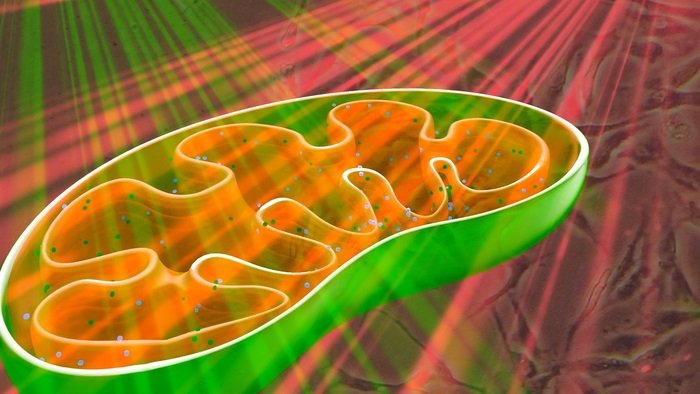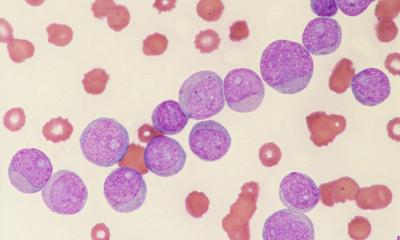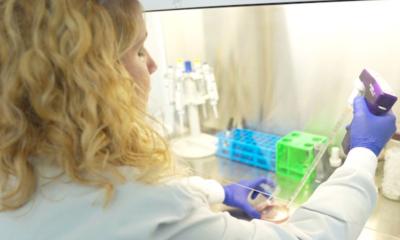
Graphic design by Therese van Wyk, University of Johannesburg. Based on Pixabay images and one image from Biochimie at https://doi.org/10.1016/j.biochi.2021.07.009
News • Irradiation
Adult stem cells transform faster with two lasers
Researchers from the University of Johannesburg find that shining a near-infrared laser on adult stem cells derived from human body fat, makes the stem cells replicate 54% faster. Following that up with a green laser, enables the stem cells to transform into different kinds of cells faster and more reliably.
Stem cell therapy needs a lot of human cells, of a specific type. Shining a near-infrared laser on adult stem cells derived from human body fat, makes the stem cells replicate 54% faster. Following that up with a green laser, enables the stem cells to transform into different kinds of cells faster and more reliably, researchers from the University of Johannesburg discovered. The consecutive irradiation results in increased proliferation and differentiation under laboratory conditions.
Most people carry some body fat around. Often the idea is to work it all off at the gym or banish it with some new eating plan. But the ‘belly fat’ so many of us resent, may one day become a source for a completely new personal form of medicine.
The human body can repair itself to some extent. Healthy skin can regrow. Strong bones heal from fractures. But people who live with conditions such as osteoporosis, know what happens when their bodies cannot do the needed repairs. Their lives shrink to what their conditions, and the medical care they can access, still allow them to do. But if there is a way to create the healthy cells needed to repair damaged tissues, new therapies can improve quality of life for people in future.
Within human fatty tissues are stashed ‘primitive’ cells called adipose stem cells. People of any age have these stem cells, which have the ability to change into bone cells, or liver or heart cells. Stem cells can, in theory, be changed on demand into any kind of cell needed to repair any part of the human body.
Shining lasers on stem cells
The current goal in stem cell research is to make the theory a practical reality. Growing tissue cells like this in a laboratory needs to happen quickly and reliably, says Prof Heidi Abrahamse. She is Director of the Laser Research Centre (LRC) at the University of Johannesburg. “The hope is that stem cell therapy for diseases such as osteoporosis will enhance the human body's own repair abilities in future. With osteoporosis, the cells that should be differentiating into bone, stop doing that. As an example, future stem cell therapy may help retain bone calcium," Abrahamse said. "Currently, clinical trials using stem cell therapies for chronic diseases are not as effective as hoped. In those trials, they use chemical or biological ways of encouraging cell differentiation. We use laser light in a technique called photobiomodulation (PBM). We shine a laser light of a specific wavelength onto stem cells to stimulate a response. Our research aims for better ways to multiply and differentiate stem cells into various tissue cells,” she adds.
Two colours in sequence
Generally, researchers shine red and near-infrared laser light on stem cells in the laboratory. These wavelengths make the cells multiply into more identical stem cells. The process is called proliferation. However, to repair any part of the body, it is also necessary to change stem cells into the other kinds of cells needed. That process is called differentiation. But red and near-infrared laser light don’t seem to encourage differentiation so much.
In an article published in Biochimie, UJ LRC researchers used a new combination of laser light as a step towards this goal. They shone green laser light (525 nanometer wavelength) on adipose-derived stem cells. They also shone green and near-infrared (825 nanometer wavelength) laser light consecutively on stem cells.
Green laser light has only recently been studied by researchers on various cell lines. “We wanted the advantages of both the near-infrared and green laser wavelengths, to get both proliferation and differentiation of stem cells. Combining the near-infrared and green laser light looks promising,” says Dr Anine Crous. She is a Postdoctoral Fellow at the LRC.
Green light for faster
Using near-infrared and green laser light in sequence resulted in 54% higher proliferation in the stem cells after seven days, than the control. There was also 50% higher reactive oxygen species, than the control – which meant the readiness for differentation was significantly higher.
The stem cells increased their ‘energy currency’ – their cellular ATP. The cells also had far higher mitochondrial membrane potential. This means the ‘powerhouses’ of the multiplied, differentiated cells could store far more energy. “Using near-infrared and green make adipose-derived stem cells multiply rapidly. It also encourages sufficient differentiation. We will be investigating this approach further for regenerative purposes,” adds Crous.
The research was conducted on commercial cell lines in the laboratory. Human clinical trials are years away.
Towards personalised medicine
“As life goes on and the body ages, it’s repair mechanism waivers. Our cells get benched and don’t play the game as hard as they used to,” says Crous.
“Luckily we have adipose stem cells concealed in our fat deposits. Along with future scientific treatments using lasers, we’ll be able to significantly enhance our bodies’ natural repair processes,” she adds.
“I see this kind of regenerative technique as a step towards personalised medicine. One day it should be possible to avoid the hard-to-manage side effects of using a ‘standard’ chemical treatment. Everyone reacts differently to medical drugs. In future, ‘tweaking’ a stem cell treatment for a particular person should be effective, with minimal side effects,” concludes Crous.
Source: University of Johannesburg
26.10.2021





